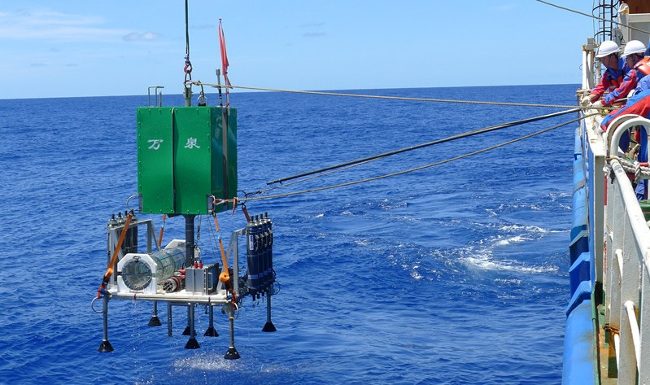Solid State Lithium Battery Powers Mariana Trench Exploration
Equipped with a solid state lithium battery as its only power source, a Chinese deep-sea lander has successfully dived into the depths of the Mariana Trench nine times.

AsianScientist (Apr. 21, 2017) A deep-sea lander built by researchers at the Chinese Academy of Sciences (CAS) has made nine successful dives at the Mariana Trench while powered only by a lithium ion battery, according to a statement from CAS.
At 10,994m, the Mariana Trench is the deepest part of the world's ocean. To understand life at such depths, expedition equipment requires high energy density power sources. In recent years, China has developed a number of batteries suitable for deep-sea expeditions, including a silver-zinc battery that successfully powered the Jiaolong manned submersible for six hours at a depth of 7,000m. However, the silver-zinc battery has a relatively low energy density (less than 60 Wh/kg) and a short cycling life (50 times), which cannot meet the requirements of long endurance and full ocean depth applications (11,000 m).
Compared with the silver-zinc batteries, lithium batteries show a significant advantages in energy density (180 Wh/kg), cycling life (500-1,000 times) and safety. However, the volatile flammable organic electrolyte in traditional lithium batteries may lead to thermal runaway or even explosion, when overcharged or when there is an internal short circuit.
Solid state electrolytes with enhanced safety can be compatible to lithium metal as the anode of the battery, increasing the battery energy density up to 400 Wh/kg (double that of the commercial lithium-ion battery, and six times that of silver-zinc battery). Such solid state electrolyte based batteries could provide adequate power output for deep-sea space stations and deep-sea robots.
To build a suitable deep-sea battery, a research team headed by Professor Cui Guanglei from the Qingdao Institute of Bioenergy and Bioprocess Technology (QIBEBT) of the Chinese Academy of Sciences, has been working on developing high-performance and high-safety lithium batteries by using the rigid-flexible coupled solid electrolyte system.
By finely tuning the molecular structure of the electrolytes and ionic conductivity, the researchers have been able to optimize the coupling of the ion transport mechanism to withstand high pressures. This system possesses several features, such as a good safety profile, long cycling life and improved working depth. The team also improved the lithium metal interface and in situ interface repair technology for the solid state lithium battery.
From January 15 to March 23, 2017, the solid state battery system (named QIBEBT-I) supplied power to the Wanquan (万泉) deep-sea lander which was brought to the Mariana Trench by the CAS deep-sea expedition team. The lander realized nine successful dives, six of which went down to a depth of 10,000m. QIBEBT-I ran for a total of 134 hours, including a continuous 20 hour stretch.
The QIBEBT team is currently working to improve the performance of their solid state lithium battery. (AsianScientist)